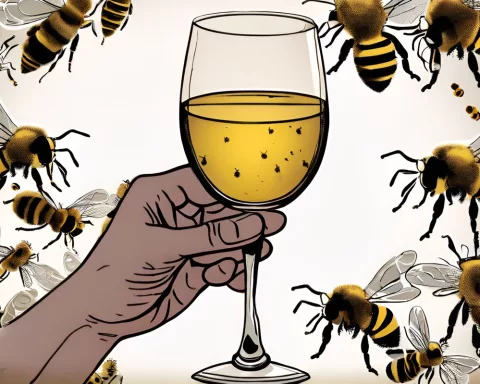South African wine producers are optimistic about a prosperous harvest in 2024, with expectations of an abundant yield despite a decrease in vineyard area. Vinpro is managing a sector restructuring with the South African Wine Industry Information & Systems to secure steady growth. While the sector faces obstacles such as soil conditions and downy mildew, CEO of South Africa Wine Rico Basson remains hopeful for value growth in tourism and markets. The industry’s resilience and adaptability are evident as it continues to prosper despite setbacks.
Will South African wine producers have a prosperous 2024 harvest?
South African wine grape cultivators predict an abundant harvest for 2024, a substantial increase compared to the sparse yields of last year. Despite the national vineyard area’s decrease, the potential advantages of favourable climate conditions for the forthcoming harvest surpass the detrimental aspects. Provided the environmental factors proceed as expected and producers amend their management strategies effectively, a high-quality harvest is anticipated.
Bright Prospects for South African Viticulture
South African wine grape cultivators predict an abundant harvest for 2024, a substantial increase compared to the sparse yields of last year. Currently, the nation’s viticulture sector is undergoing a restructuring phase to address a myriad of obstacles and secure steady growth. Vinpro, under the leadership of manager Etienne Terblanche, is managing this transformation, working closely with the South African Wine Industry Information & Systems (SAWIS).
Despite the national vineyard area’s decrease — with SAWIS’s 2022 data showing a total coverage of 89,384 hectares — the potential advantages of favourable climate conditions for the forthcoming harvest surpass the detrimental aspects. As Terblanche puts it, “The potential ramifications of load shedding will only come to the fore as we approach harvesting time. We’re monitoring this closely. Provided the environmental factors proceed as expected and producers amend their management strategies effectively, we anticipate a high-quality harvest.”
Recovery and Resilience Amid Challenges
The period after the previous year’s harvest was defined by a move toward colder and more humid conditions, advantageous for vine recovery. The vineyards had a vigorous beginning in winter, thanks to last year’s reduced crop load, the early end of the harvest, and abundant water supply. Lower temperatures and above-average precipitation were instrumental in replenishing soil profiles and storage dams, imparting a unique advantage to dryland areas such as Cape Town and Swartland.
However, vineyards situated near riverbanks felt the impact of the September floods most acutely, leading to problematic soil conditions, silt buildup on leaves, and increased humidity. Furthermore, there was restricted access to vineyards due to saturated soil and the risk of downy mildew. Despite these obstacles, the early summer brought milder temperatures and less rainfall, which spurred growth and encouraged flowering and setting for most grape varieties.
Overcoming Hurdles and Fostering Growth
The setting of late varieties, especially Cabernet Sauvignon, was somewhat hindered by powerful winds in coastal regions, for example, Stellenbosch. Still, Rico Basson, CEO of South Africa Wine, holds a hopeful outlook. He expresses confidence that the South African wine sector is well-positioned to conquer these challenges and stimulate value growth in tourism, local and international markets. This strategy could help ease the financial burden at the farm level.
As we look forward, the team of viticulturists and producer cellars is getting ready to publish the subsequent crop estimate in January 2024. This forecast will provide more information about the industry’s performance and potential growth areas.
Celebrating the Resilience of the South African Wine Industry
In the meantime, as we raise a glass for the hopeful prospect of a more fruitful harvest next year, let’s also acknowledge the remarkable resilience and adaptability of the South African wine industry. Despite the difficulties and setbacks, the industry persists and prospers, sketching a promising image of what’s to come. So, here’s to the South African wine industry – may it continue to tackle challenges and unfold new tales of success.
1. What is the outlook for South African wine producers for the 2024 harvest?
South African wine grape cultivators predict an abundant harvest for 2024, with expectations of high-quality yields despite a decrease in vineyard area. The potential advantages of favourable climate conditions for the forthcoming harvest surpass the detrimental aspects, and producers are confident in their management strategies.
2. What obstacles do South African wine producers face?
South African wine producers face obstacles such as soil conditions, downy mildew, and floods that impact vineyards near riverbanks. The industry is also undergoing a restructuring phase to address various challenges and secure steady growth.
3. How is Vinpro managing the transformation of the South African wine industry?
Vinpro is managing the sector restructuring under the leadership of manager Etienne Terblanche, working closely with the South African Wine Industry Information & Systems (SAWIS) to secure steady growth.
4. What is the potential for value growth in tourism and markets?
Rico Basson, CEO of South Africa Wine, remains hopeful for value growth in tourism and markets. This strategy could help ease the financial burden at the farm level and stimulate growth for the industry.
5. When will the subsequent crop estimate be published?
The team of viticulturists and producer cellars is getting ready to publish the subsequent crop estimate in January 2024. This forecast will provide more information about the industry’s performance and potential growth areas.
6. What is the state of the South African wine industry’s resilience and adaptability?
Despite setbacks and challenges, the South African wine industry remains resilient and adaptable, continuing to prosper and unfold new tales of success. The industry’s ability to overcome obstacles is a promising sign for the future.












